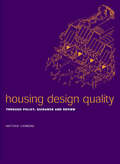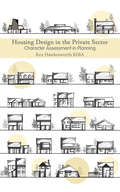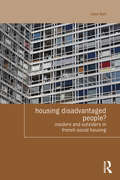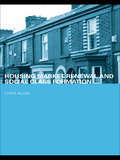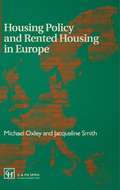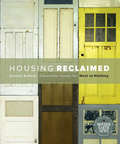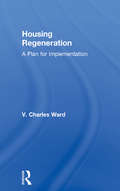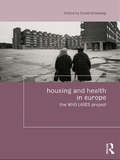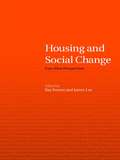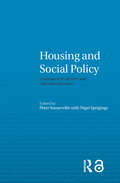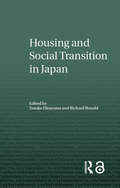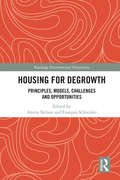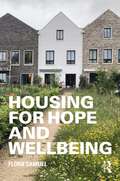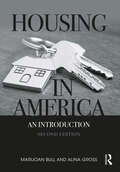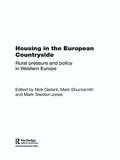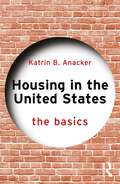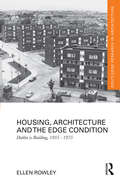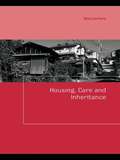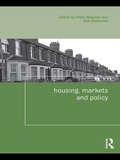- Table View
- List View
Housing Decisions
by Evelyn L. Lewis Carolyn S. TurnerLewis (emeritus, home economics, Northern Arizona U. , Flagstaff) and Turner (housing research, North Carolina Agricultural and Technical State U. , Greensboro) address numerous aspects of housing including related careers. This textbook's 7th incarnation (the last being in 2000) features color illustrations, relevant US legislation, energy-saving tips, and a glossary.
Housing Design Quality: Through Policy, Guidance and Review
by Matthew CarmonaThis book directly addresses the major planning debate of our time - the delivery and quality of new housing development. As pressure for new housing development in England increases, a widespread desire to improve the design of the resulting residential environments becomes evermore apparent with increasing condemnation of the standard products of the volume housebuilders.In recent years central government has come to accept the need to deliver higher quality living environments, and the important role of the planning system in helping to raise design standards. Housing Design Quality focuses on this role and in particular on how the various policy instruments available to public authorities can be used in a positive manner to deliver higher quality residential developments.
Housing Design in the Private Sector: Character Assessment in Planning
by Rex Hawkesworth RibaNever before has house design been a science; it has always been a subjective desire of a rich person who can throw money away to achieve a personal satisfaction of something for him or her. At the opposite end of scale, i.e., housing for ordinary people, you only have to look at Victorian slums to see the outcome - profit. It is not normal for householders to consider the buyer much more than a chance of bathroom or kitchen fittings. Smaller developers are more liable to consider the buyer, provided, of course, the design is straightforward and economical. If densities are met, the architect can probably plot his or her artistic thoughts even more. Therefore, modern housing generally has a traditional look about it. Beyond that, design initiatives are hidden or subtly designed so that the client's vision is not interfered with; a greater depth of understanding is produced if adjoining sites or buildings are taken into account to add sensibility or satisfaction to the design, but this can only be achieved in individual designs and not estates. This is what this book is all about: making the most of the site and its neighbours.
Housing Disadvantaged People?: Insiders and Outsiders in French Social Housing (Housing and Society Series)
by Jane BallSocial housing appears to offer a solution for the housing of poor and disadvantaged people. The French "right to housing" offers poor and disadvantaged citizens priority in social housing allocation, and even a legal action against the State to obtain a social home. Despite this, France is suffering a long-lasting housing crisis with disadvantaged people having particular difficulties of access, often despite the efforts of local housing actors. This situation is affected by the European Court of Human Rights and EU decisions limiting diverse national housing and rental policies. Between historic French revolutions and the modern riots, negotiated solutions to social dilemmas emerged. Despite progress in constitutional principles, complex local negotiations still ultimately determine who is housed. Local social landlords, mayors and employee and tenant representatives use their privileges to house their insiders: existing tenants, locals and employees, with rent insufficiently subsidized. ‘Insider Outsider’ theory is used for an economic analysis of exclusion in social housing allocation: its processes, institutional context, and stigmatizing effects. This highlights the spatial effects of nimbyism, excluding disadvantaged outsiders, and concentrating them in deprived areas. Simultaneously, urban regeneration reduced affordable housing stock and ‘social mix’ became a reason to refuse a social home. History, comparative law, economic theory and local interviews with housing actors give a detailed picture of what happens in and around French social housing allocation for an interdisciplinary housing policy audience. Constitutional principles appear in an unfamiliar guise as negotiating positions, with the "right to property" supporting landlords and the "right to housing" supporting tenants. French debates about the function of social landlords are echoed across Europe and reflected in European policies concerning rights, and the exclusion of disadvantaged minorities.
Housing Market Renewal and Social Class (Housing, Planning and Design Series)
by Chris AllenHousing market renewal is one of the most controversial urban policy programmes of recent years. Housing Market Renewal and Social Class critically examines the rationale for housing market renewal: to develop 'high value' housing markets in place of the so-called 'failing markets' of low-cost housing. Whose interests are served by such a programme and who loses out? Drawing on empirical evidence from Liverpool, the author argues that housing market renewal plays to the interests of the middle classes in viewing the market for houses as a field of social and economic 'opportunities', a stark contrast to a working class who are more concerned with the practicalities of 'dwelling'. Against this background of these differing attitudes to the housing market, Housing Market Renewal and Social Class explores the difficult question of whether institutions are now using the housing market renewal programme to make profits at the expense of ordinary working-class people. Reflecting on how this situation has come about, the book critically examines the purpose of current housing market renewal policies, and suggests directions for interested social scientists wishing to understand the implications of the programme. Housing Market Renewal and Social Class provides a unique phenomenological understanding of the relationship between social class and the market for houses, and will be compelling reading for anybody concerned with the situation of working class people living in UK cities.
Housing Policy and Rented Housing in Europe
by Michael Oxley Jaqueline SmithThe book will inform a wide audience about the provision of rented housing in several European countries. The material is relevant to many housing, surveying and planning undergraduate and postgraduate courses which have a European housing element/option.
Housing Reclaimed
by Jessica KellnerHousing is a fundamental human right. For most of human history, our homes were built by hand from whatever local materials were available. However, since the Industrial Revolution, most housing has become little more than quickly constructed, mass-produced, uniform boxes. At the same time, the invention and standardization of the thirty-year mortgage and our ever-increasing reliance on credit has come to mean that most of us never own our homes outright.Housing Reclaimed is a call to arms for nonconventional home builders. It examines how technological advances, design evolution, and resourceful, out-of-the-box thinking about materials and efficiency can help us meet the challenge of building affordable, environmentally friendly, beautiful, and unique homes. Focusing on the use of salvaged and reclaimed materials, this inspirational volume is packed with case studies of innovative projects including:*Phoenix Commotion-working together towards low-income home ownership through sweat equity and 100 percent recycled materials*HabeRae-revitalizing neighborhoods by creating urban infill using modern technology and sustainable and reclaimed materials*Builders of Hope-rescuing and rehabilitating whole houses slated for demolitionThese projects and others like them demonstrate that building one's own home does not have to be an unattainable dream. This beautifully illustrated guide is a must-read for anyone interested in creating quality zero- or low-debt housing, reducing landfill waste, and creating stronger communities.Jessica Kellner is the editor of Natural Home and Garden magazine and a passionate advocate of using architectural salvage to create aesthetically beautiful, low-cost housing.
Housing Regeneration: A Plan for Implementation
by V. Charles WardWritten from an ‘in house’ perspective in response to the UK Government Housing White Paper released in February 2017, Housing Regeneration: A Plan for Implementation presents sustainable solutions to Britain’s housing crisis and will be a useful practical guide for anyone involved in the process of regeneration. Taking as its starting point an idea for a housing regeneration scheme, it provides an overview of each of the issues to be considered and the options for addressing them. In clear and concise language, it explains the issues and work involved in a regeneration scheme, answering questions such as who is involved, how is it paid for, what options are available and, importantly, what are the risks. It will appeal to lawyers, councillors, town planners, surveyors, chief officers, finance officers, procurement officers, project managers and students, amongst others.
Housing Transformations: Shaping the Space of Twenty-First Century Living (Housing and Society Series)
by Bridget FranklinDrawing together a wide range of literature, this original book combines social theory with elements from the built environment disciplines to provide insight into how and why we build places and dwell in spaces that are at once contradictory, confining, liberating and illuminating. This groundbreaking book deals with topical issues, which are helpfully divided into two parts. The first presents a conceptual framework examining how the built environment derives from a variety of influences: structural, institutional, textual, and action-orientated. Using illustrated case study examples, the second part covers new build schemes, including urban villages, gated communities, foyers, retirement homes and televillages, as well as refurbishment projects, such as mental hospitals and tower blocks. Multidisciplinary in its focus, Housing Transformations will appeal to academics, students and professionals in the fields of housing, planning, architecture and urban design, as well as to social scientists with an interest in housing.
Housing and Health in Europe: The WHO LARES project (Housing and Society Series)
by David OrmandyIn this cross-disciplinary research David Ormandy and expert contributors explain the nature and development of the World Health Organization's study of housing across Europe. In-depth analysis provides new evidence of links between the health of inhabitants and their housing conditions, with focus on critical topics such as: indoor air pollution the effect of cold homes and dampness noise effects domestic accidents. With practical examples of survey tools, the attention given to methodological approaches makes this text an important resource for policy professionals as well as housing, planning and public health academics.
Housing and Interior Design
by Evelyn L. Lewis Carolyn S. TurnerHousing and Interior Design is the perfect choice for introducing students to the fascinating world of housing and interior design. With a striking design and beautiful illustrations, this teaching package helps students examine housing needs and choices, the basic principles of interior design and design presentation, and opportunities in a wide range of housing and interior design careers. In addition, the text: * Examines historical, cultural, and technological influences on housing and interiors. * Addresses architectural styles and housing types along with universal design for all people. * Introduces the elements and principles of design and their indoor and outdoor applications. Also presents the phases of the design process. * Highlights green and sustainable design and ecological issues in the Green Choices features. * Profiles numerous housing and interior design careers in the Career Focus features. * Includes a wealth of chapter review materials that help students apply text concepts, including Think Critically, Community Links, Academic Connections, Technology Applications, Design Practice, and FCCLA.
Housing and Interior Design
by Evelyn L. Lewis Carolyn S. TurnerHousing and Interior Design is the perfect choice for introducing students to the fascinating world of housing and interior design. With a striking design and beautiful illustrations, this teaching package helps students examine housing needs and choices, the basic principles of interior design and design presentation, and opportunities in a wide range of housing and interior design careers. <p><p> In addition, the text: Examines historical, cultural, and technological influences on housing and interiors. Addresses architectural styles and housing types along with universal design for all people. Introduces the elements and principles of design and their indoor and outdoor applications. Also presents the phases of the design process. Highlights green and sustainable design and ecological issues in the Green Choices features. Profiles numerous housing and interior design careers in the Career Focus features.
Housing and Social Change: East-West Perspectives (Housing and Society Series)
by James Lee Ray ForrestThis wide-ranging exploration of the key contemporary relationships between social change and housing is both policy-oriented and theoretical, drawing on a group of internationally-respected academics. It is also multidisciplinary, incorporating sociology, economics, social policy and human geography perspective. Its international perspective is rooted in its examination of issues such as economic insecurity and instability, social diversity, financial and social exclusion, sustainability, privatisation and state legitimacy, the interaction of the global and the local across three continents.
Housing and Social Policy: Contemporary Themes and Critical Perspectives (Housing and Society Series)
by Peter Somerville Nigel SprigingsThis topical book transforms the analysis of housing problems into a lively, interesting and contentious subject of social scientific study, addressing themes of residential experience, inclusion/empowerment, sustainability and professionalism/managerialism, which lie at the heart of the housing and social policy debate. Each chapter considers a specific social category - such as class, gender, or disability - and evaluates the experience and understanding of housing and social policy under this category. With innovative approaches to conceptualising housing and a clear, defined structure, Housing and Social Policy encourages students and practitioners in both arenas to think reflexively about housing as a central instrument of social policy and social experience.
Housing and Social Transition in Japan (Housing and Society Series)
by Richard Ronald Yosuke HirayamaBringing together a number of perspectives on the Japanese housing system, Housing and Social Transition in Japan provides a comprehensive, challenging and theoretically developed account of the dynamic role of the housing system during a period of unprecedented social and economic change in one of the most enigmatic social, political, and economic systems of the modern world. While Japan demonstrates many of the characteristics of some western housing and social systems, including mass homeownership and consumption-based lifestyles, extensive economic growth and rapid urban modernization has been achieved in balance with traditional social values and the maintenance of the family system. Helpfully divided into three sections, Housing and Social Transition in Japan: explores the dynamics of the development of the housing system in post-war Japan deals with social issues related to housing in terms of social aging, family relations, gender and inequality addresses the Japanese housing system and social change in relation to comparative and theoretical frameworks. As well as providing challenges and insights for the academic community at large, this book also provides a good introduction to the study of Japan and its housing, economic, social and welfare system generally.
Housing for Degrowth: Principles, Models, Challenges and Opportunities (Routledge Environmental Humanities)
by Anitra Nelson François Schneider‘Degrowth’, a type of ‘postgrowth’, is becoming a strong political, practical and cultural movement for downscaling and transforming societies beyond capitalist growth and non-capitalist productivism to achieve global sustainability and satisfy everyone’s basic needs. This groundbreaking collection on housing for degrowth addresses key challenges of unaffordable, unsustainable and anti-social housing today, including going beyond struggles for a 'right to the city' to a 'right to metabolism', advocating refurbishment versus demolition, and revealing controversies within the degrowth movement on urbanisation, decentralisation and open localism. International case studies show how housing for degrowth is based on sufficiency and conviviality, living a ‘one planet lifestyle’ with a common ecological footprint. This book explores environmental, cultural and economic housing and planning issues from interdisciplinary perspectives such as urbanism, ecological economics, environmental justice, housing studies and policy, planning studies and policy, sustainability studies, political ecology, social change and degrowth. It will appeal to students and scholars across a wide range of disciplines.
Housing for Hope and Wellbeing
by Flora SamuelHousing and neighbourhoods have an important contribution to make to our wellbeing and our sense of our place in the world. This book, written for a lay audience (with policy makers firmly in mind) offers a useful and intelligible overview of our housing system and why it is in ‘crisis’ while acting as an important reminder of how housing contributes to social value, defined as community, health, self development and identity. It argues for a holistic digital map-based planning system that allows for the sensitive balancing of the triple bottom line of sustainability: social, environmental and economic value. It sets out a vision of what our housing system could look like if we really put the wellbeing of people and planet first, as well as a route map on how to get there. Written primarily from the point of view of an architect, the account weaves across industry, practice and academia cross cutting disciplines to provide an integrated view of the field. The book focusses on the UK housing scene but draws on and provides lessons for housing cultures across the globe. Illustrated throughout with case studies, this is the go-to book for anyone who wants to look at housing in a holistic way.
Housing in America: An Introduction
by Marijoan Bull Alina GrossHousing is a fundamental need and universal part of human living that shapes our lives in profound ways that go far beyond basic sheltering. Where we live can determine our self-image, social status, health and safety, quality of public services, access to jobs, and transportation options. But the reality for many in America is that housing choices are constrained: costs are unaffordable, discriminatory practices remain, and physical features do not align with needs. We have made a national commitment to decent housing for all, yet this promise remains unrealized. Housing in America provides a broad overview of the field of housing. The evolution of housing norms and policy is explored in a historical context while underscoring the human and cultural dimensions of housing program choices. Specific topics covered include: why housing matters; housing and culture; housing frameworks and political ideologies; housing and opportunities; housing and the economy; housing discrimination; housing affordability; rental housing; and housing and climate change. Readers will gain an understanding of the basic debates within the field of housing, consider the motivations and performance of various interventions, and critically examine persistent patterns of racial and class inequality. With short case studies, primary source materials, reflective exercises, strong visuals, and interviews with practitioners, this introductory text explores improving housing choices in America.
Housing in Post-Growth Society: Japan on the Edge of Social Transition (Explorations in Housing Studies)
by Misa Izuhara Yosuke HirayamaIn a globalising world, many mature economies share post-growth characteristics such as low economic growth, low fertility, declining and ageing of the population and increasing social stratification. Japan stands at the forefront of such social change in the East Asian region as well as in the Global North. It is in this context of ‘post-growth society’ that housing issues are examined, using the experiences of Japan at the leading edge of social transition in the region. The post-war housing system was developed during the golden age of economy and welfare, when upward social trajectories such as increasing population, high-speed economic growth with rising real incomes, housing construction driven by high demands, increasing rates of home ownership supported by generous government subsidies generated new housing opportunities and accompanying issues. As we have entered the post-growth phase of socio-economic development, however, it requires a re-examination of such structure, policy and debates. This volume explores what roles housing plays in the reorganisation and reconstruction of economic processes, social policy development, ideology and identity, and intergenerational relations. The volume offers a greater understanding of the characteristics of post-growth society – changing demography, economy and society – in relation to housing. It considers how a definitive shift to the post-growth period has produced new housing issues including risks as well as opportunities. Through analysis of the impact on five different areas: post-crisis economy, urban and regional variations, young adults and housing pathways, fertility and housing, and ageing and housing wealth, the authors use policy and institutions as overarching analytical tools to examine the contemporary housing issues in a post-growth context. It also considers any relevance from the Japanese experiences in the wider regional and global context. This original book will be of great interest to academics and students as well as policy makers and practitioners internationally in the fields of housing studies, urban studies, social policy, sociology, political economy, comparative analysis, and East Asian Studies.
Housing in the European Countryside: Rural Pressure and Policy in Western Europe (Housing, Planning and Design Series)
by Nick Gallent Mark Tewdwr-Jones Mark ShucksmithHousing in the European Countryside provides an overview of the housing pressures and policy challenges facing Europe, while highlighting critical differences. By drawing on contemporary research work of leading authors in the fields of housing studies, rural geography and planning, the book provides an introduction to housing issues across the European countryside for those who have hitherto been unexposed to such concerns, and who wish to gain some basic insight. This in-depth review of housing pressure in the European countryside reveals both the form, nature and variety of problems now being experienced in different parts of Europe, in addition to outlining policy solutions that are being provided by member states and other agencies in meeting the rural housing challenge at this time and in the years ahead.
Housing in the United States: The Basics (The Basics)
by Katrin B. AnackerHousing matters to people, be they owner, renter, housing provider, homeless individual, housing professional, or policymaker. Housing in the United States: The Basics offers an accessible introduction to key concepts and issues in housing—and a concise overview of the programs that affect housing choices, affordability, and access in the United States today. Part I covers the fundamentals of housing: households, housing units, and neighborhoods; housing as basic need vs. human right; supply and demand; construction, rehabilitation, and renovation; and demographic, socioeconomic, and cultural trends. Part II focuses on housing policy and its evolution from the early 20th century, through the Great Recession to the present day; policies related to owner- and renter-occupied housing; tax policies and expenditures; place- and people-based programs; and shortages of affordable housing.Written in a clear and engaging style, this guide allows readers to quickly grasp the complex range of policies, programs, and factors that shape the housing landscape. Essential reading for students, community advocates, homebuyers/renters, and professionals with an interest in housing, it also serves as an ideal text for introductory courses in urban planning, urban studies, sociology, public administration, architecture, and real estate.This book provides a valuable and practical foundation for informed housing discussions at the kitchen table, in the classroom, at work, or on Capitol Hill.
Housing, Architecture and the Edge Condition: Dublin is building, 1935 - 1975 (Routledge Research in Architecture)
by Ellen RowleyThis book presents an architectural overview of Dublin’s mass-housing building boom from the 1930s to the 1970s. During this period, Dublin Corporation built tens of thousands of two-storey houses, developing whole communities from virgin sites and green fields at the city’s edge, while tentatively building four-storey flat blocks in the city centre. Author Ellen Rowley examines how and why this endeavour occurred. Asking questions around architectural and urban obsolescence, she draws on national political and social histories, as well as looking at international architectural histories and the influence of post-war reconstruction programmes in Britain or the symbolisation of the modern dwelling within the formation of the modern nation. Critically, the book tackles this housing history as an architectural and design narrative. It explores the role of the architectural community in this frenzied provision of housing for the populace. Richly illustrated with architectural drawings and photographs from contemporary journals and the private archives of Dublin-based architectural practices, this book will appeal to academics and researchers interested in the conditions surrounding Dublin’s housing history.
Housing, Care and Inheritance (Housing and Society Series)
by Misa IzuharaHousing, Care and Inheritance draws on the author’s long-standing research into housing issues surrounding the ageing society, a phenomenon which is now a concern in many mature economies. If an adult child provides care for their elderly parent, should that person be rewarded? If so, should they inherit their parent’s house or a larger share of the assets? The ‘generational contract’ is often influenced by cultural norms, family traditions, social policy and housing market, so it is negotiated differently in different societies and at different times. Such generational contract is however breaking down as a result of socio-economic and demographic changes. Drawn from the two-part study funded by the UK Economic & Social Research Council, Misa Izuhara explores the myth and the changing patterns of the particular exchange of long-term care and housing assets between older parents and their adult children in Britain and Japan. Highly international and comparative in perspectives, this study addresses important sociological as well as policy questions regarding intergenerational relations involving housing wealth, long-term care, and inheritance.
Housing, Markets and Policy (Housing and Society Series)
by Peter Malpass Rob RowlandsThis book of specially commissioned essays by distinguished housing scholars addresses the big issues in contemporary debates about housing and housing policy in the UK. Setting out a distinctive and coherent analysis, it steers a course between those accounts that rely on economic theory and analysis and those that emphasize policy. It is informed by the idea that the 1970s was a pivotal decade in the second half of the twentieth century, and that since that time there has been a profound transformation in the housing system and housing policy in the UK. The contributors describe, analyze and explain aspects of that transformation, as a basis for understanding the present and thinking about the future. The analysis of housing is set within an understanding of the wider changes affecting the economy and the welfare state since the crises of the mid 1970s.

